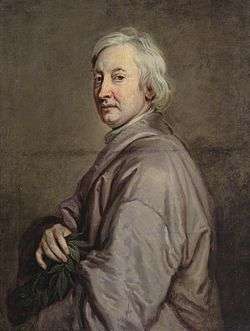Sense-for-sense translation
| Part of a series on |
| Translation |
|---|
| Types |
| Theory |
| Technologies |
| Localization |
| Institutional |
|
| Related topics |
|
Sense-for-sense translation is the oldest norm for translating. It fundamentally means translating the meaning of each whole sentence before moving on to the next, and stands in normative opposition to word-for-word translation (also known as literal translation), which means translating the meaning of each lexical item in sequence.
History
The coiner of the term "sense-for-sense" was Jerome in his "Letter to Pammachius", where he said that, "except of course in the case of Holy Scripture, where even the syntax contains a mystery," he translates non verbum e verbo sed sensum de sensu: not word for word but sense for sense.[1]
However, arguably Jerome is here not inventing the concept of sense-for-sense translation, which most scholars believe was invented by Cicero in De Oratore ("On the Orator"), when he said that in translating from Greek to Latin "I did not think I ought to count them out to the reader like coins, but to pay them by weight, as it were."[2]
And he is certainly not even coining the term "word-for-word," but borrowing it from Cicero as well, or possibly from Horace, who warned the writer interested in retelling ancient tales in an original way Nec verbo verbum curabit reddere / fidus interpretes: "not to try to render them word for word [like some] faithful translator."[3]
Some have read that passage in Horace differently:
- Boethius in 510 CE and Johannes Scotus Eriugena in the mid-9th century read it to mean that translating literally is "the fault/blame of the faithful interpreter/translator," and fear that they have incurred it; Burgundio of Pisa in the 1170s and Sir Richard Sherburne in 1702 recognize that Horace is advising not translators but original writers, but still assume that he is calling all translation literal; and John Denham in 1656 and André Lefevere in 1992 take Horace to be warning translators against translating literally.[4]
Similar concepts
Metaphrase, paraphrase and imitation

In John Dryden’s 1680 preface to his translation of Ovid's Epistles, he proposed dividing translation into three parts called: metaphrase, paraphrase and imitation.[5] Metaphrase is word-for-word and line by line translation from one language into another.[6] Paraphrase is sense-for-sense translation where the message of the author is kept but his words are not so strictly followed as his sense, which too can be altered or amplified.[7] Imitation is the use of either metaphrase or paraphrase but the translator has the liberty to choose which is appropriate and how the message will be conveyed.[8]
Leaving the writer in peace and leaving the reader in peace
In 1813, during his “Über die Verschiedenen Methoden des Übersetzens” lecture,[9] Friedrich Schleiermacher proposed the idea where “[E]ither the translator leaves the author in peace, as much as possible, and moves the reader towards him, or he leaves the reader in peace, as much as possible, and he moves the author towards him”.[10]
Formal and dynamic equivalence
In 1964,[11] Eugene Nida described translation as having two different types of equivalence: formal and dynamic equivalence.[12] Formal equivalence is when there is focus on the message itself, in both form and content.[13] The message in the target language should match the message in the source language as closely as possible.[14] In contrast, there is less concern with matching the message in the target language with the message in the source language in dynamic equivalence.[15] The goal is, however, to produce the same relationship between target text and target audience, as there was with the original source text and its audience.[16]
Semantic and communicative translation
In 1981, Peter Newmark referred to translation as either semantic (word-for-word) or communicative (sense-for-sense).[17] He stated that semantic translation is one that is source language bias, literal and faithful to the source text and communicative translation is target language bias, free and idiomatic.[18] A semantic translation’s goal is to stay as close as possible to the semantic and syntactic structures of the source language, allowing the exact contextual meaning of the original.[19] A communicative translation’s goal is to produce on the readers an effect as close as possible to that produced upon the readers of the original.[20]
Idiomatic and unidiomatic translation
In addition to these concepts, in 1990, Brian Mossop presented his concept of idiomatic and unidiomatic translation.[21] Idiomatic translation is when the message of the source text is conveyed the way a target language writer would convey it, rather than staying to the way in which it was conveyed in the source text.[22] Unidiomatic translation is innovative and translates individual words.[23]

Domesticated and foreignized translation
In 1994, also in modern Translation Studies, Lawrence Venuti introduced the concepts of domestication and foreignization, which are based on concepts from Friedrich Schleiermacher's 1813 lecture.[24] Domestication is the adaption of culture-specific terms or cultural context, where as foreignization is the preservation of the original cultural context of the source text (in terms of settings, names, etc.).[25] Venuti also described domestication as being fluent and transparent strategies that result in acculturation,[26] where “a cultural other is domesticated, made intelligible”.[27] Schleiermacher's distinction between "bringing the author to the reader" (domestication) and "taking the reader to the author"[28] (foreignization), dealt with a social concern and Venuti’s distinction between domestication and foreignization deals with ethical principles.[29]
Segmentation
The technical term for the approach to translation that distinguishes between sense-for-sense and word-for-word translation is "segmentation": the two methods are essentially different ways of segmenting the source text for translation, into individual words or phrases, clauses, sentences, and larger textual units.
In rare cases, sense-for-sense translation overlaps with word-for-word translation. For example, when the German sentence Johan ist nicht zu Hause is translated as Johan is not at home, that target text is an "idiomatic translation"[30] of the whole sentence that also renders word for word:
- Johan
- ist = is
- nicht = not
- zu = at
- Hause = home
It could also be argued, of course, that zu Hause is literally "to house," and that translating it "at home" effectively renders the two words not as two words but as a coherent idiom. This reading would undermine the claim that the translation "Johan is not at home" is both word-for-word and sense-for-sense: "at home" would be a sense-for-sense but not word-for-word rendering.
Cases in which a sense-for-sense is identical to a word-for-word translation are extremely rare because different languages almost invariably structure sentences differently (use different syntagmata or word orders). To reproduce some close approximation of the meaning of a whole sentence in another language, therefore, one must almost always change the word order to reflect the idiomatic syntagmata of the target language.
The fact that most translators and translation commentators have preferred sense-for-sense over word-for-word translation reflects the common assumption that the purpose of all translation is to communicate the meaning of the source text in a way that will be easily accessible to the target reader. Proponents of various literalisms (including foreignisms) dispute that generalization.
References
- ↑ Douglas Robinson, ed., Western Translation Theory from Herodotus to Nietzsche (Manchester, UK: St. Jerome, 1997, 2ed 2002), 25.
- ↑ Robinson, ed., Western Translation Theory, 9.
- ↑ Robinson, ed., Western Translation Theory, 15.
- ↑ For Boethius, Eriugena, Burgundio, and Denham, see Robinson, ed., Western Translation Theory, 35, 37, 42, and 156. For Sherburne, see T. R. Steiner, English Translation Theory, 1650–1800 (Amsterdam: Rodopi, 1975), 89. André Lefevere's translation of Horace appears in Lefevere, ed., Translation/History/Culture: A Sourcebook (London and New York: Routledge, 1992), 15: "Do not worry about rendering word for word, faithful translator, but render sense for sense." This of course not only makes Horace's advice for the writer into advice for the translator, but anachronistically imports Jerome's coinage back into Horace's dictum, which actually preceded it by four centuries. For discussion, see also Douglas Robinson, Who Translates (Albany: SUNY Press, 2001), 170–174.
- ↑ Lawrence Venuti, The Translation Studies Reader. 3rd ed. (New York: Routledge, 2012.), page 38.
- ↑ Venuti, The Translation Studies Reader, 3rd ed., 38.
- ↑ Venuti, The Translation Studies Reader, 3rd ed., 38.
- ↑ Venuti, The Translation Studies Reader, 3rd ed., 38.
- ↑ Yves Gambier, Luc Van Doorslaer, Handbook of Translation Studies, (Amsterdam: John Benjamins Pub., 2010.), 40.
- ↑ Gambier, Handbook of Translation Studies, 40.
- ↑ Shabnam Shakernia, “Study of Nida’s (Formal and Dynamic Equivalence) and Newmark’s (Semantic and Communicative Translation) Translating Theories on Two Short Stories”, Merit Research Journal of Education and Review 2, no. 1 (2013): 001-007. Accessed December 4, 2016. http://www.meritresearchjournals.org/er/index.htm, page 002.
- ↑ Lawrence Venuti,. The Translation Studies Reader. (New York: Routledge, 2000.), page 129.
- ↑ Lawrence Venuti, The Translation Studies Reader. (New York: Routledge, 2000.), page 129.
- ↑ Venuti, The Translation Studies Reader, 129.
- ↑ Venuti, The Translation Studies Reader, 129.
- ↑ Venuti, The Translation Studies Reader, 129.
- ↑ Peter Newmark, Approaches to Translation, (Oxford: Pergamon Press, 1981)
- ↑ Newmark, Approaches to Translation, 31
- ↑ Newmark, Approaches to Translation, 39
- ↑ Newmark, Approaches to Translation, 39
- ↑ Brian Mossop, "Translating Institutions and “Idiomatic” Translation." Meta: Journal des traducteurs 35, no. 2 (January 1990)
- ↑ Mossop, “Translating Institutions,”, 343
- ↑ Mossop, “Translating Institutions,”, 343
- ↑ Gambier, Handbook of Translation Studies, 40.
- ↑ Gambier, Handbook of Translation Studies, 40.
- ↑ Gambier, Handbook of Translation Studies, 40.
- ↑ Lawrence Venuti, "Genealogies of Translation Theory: Schleiermacher." TTR : Traduction, Terminologie, Rédaction 4, no. 2 (1991)
- ↑ Douglas Robinson, ed. Western Translation Theory From Herodotus to Nietzsche. (Manchester: St. Jerome., 2002)
- ↑ Gambier, Handbook of Translation Studies, 40.
- ↑ Ziaul Haque, Md. "Translating Literary Prose: Problems and Solutions", International Journal of English Linguistics, vol. 2, no. 6; 2012, p. 107. Retrieved on April 02, 2015.
Further reading
- Gentzler, Edwin (2001). Contemporary Translation Theories. 2nd Ed. London and New York: Routledge.
- Lefevere, André. (1992). Translation/History/Culture: A Sourcebook. London and New York: Routledge.
- Newmark, Peter. (1988). A Textbook of Translation. New York: Prentice Hall.
- Nida, Eugene A., and Charles R. Taber. (1969). The Theory and Practice of Translation. Leiden: Brill.
- Robinson, Douglas. (2001). Who Translates? Translator Subjectivities Beyond Reason. Albany: SUNY Press.
- Robinson, Douglas, ed. (2002). Western Translation Theory From Herodotus to Nietzsche. Manchester: St. Jerome.
- Steiner, T.R. (1975). English Translation Theory, 1650–1800. Amsterdam: Rodopi.
- Venuti, Lawrence. (1995). The Translator's Invisibility: A History of Translation. London and New York: Routledge (Read full version here)